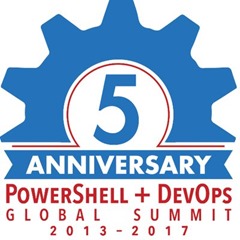PowerShell Remoting and Kerberos Double Hop: Old Problem - New Secure Solution
 PowerShell and DevOps Global Summit 2017
PowerShell and DevOps Global Summit 2017
This week I enjoyed presenting at the PowerShell and DevOps Global Summit 2017. If you have not attended, I highly encourage it. You will get to meet PowerShell team members from Microsoft, MVPs, and the people you follow on Twitter! Follow @PshSummit on Twitter to get the alerts for registration. I even work for Microsoft, and I learn a ton every year from the amazing sessions. It is also great connecting with everyone in the PowerShell community.
See this previous blog post for the benefits of resource-based Kerberos constrained delegation and how it can apply to PowerShell remoting. It is not a complete solution, but it works for the key scenarios described below and a few others. The article also outlines a number of other possible Kerberos double hop solutions. The PowerShell documentation team took that article, tweaked it, and turned it into a documentation page here.
tl;dr
- This is a follow up to my previous blog post on Kerberos double hop and PowerShell remoting.
- I have published some helper functions for working with resource-based Kerberos constrained delegation (RB KCD) and PowerShell remoting:
Enable-RBKCD,Disable-RBKCD,Get-RBKCD. - Get the files and slides on my GitHub here.
- RB KCD works with a limited set of commands and functions running under SYSTEM account in the kernel context.
- RB KCD does not support WinRM / PowerShell remoting, because that runs under the NETWORK account.
- For cases where RB KCD does not work you can nest two
Invoke-Commandstatements to make the double hop. See helper functionInvoke-DoubleHop. - You can share these RB KCD articles and scripts with this short link: https://aka.ms/pskdh
The Problem
Classic Kerberos Double Hop
I am on ServerA, connected to ServerB where I need to reach ServerC. I have permissions to ServerC, but I still get Access Denied. Default Kerberos rules prevent ServerB from passing credentials to ServerC. The most common example is a user (ServerA) connected to a web server (ServerB/frontend) that needs to use the user's credentials to access a database server (ServerC/backend). In a previous blog post I described multiple popular (and not-so-popular) work-arounds.
Scenario A: Jump Server
From my workstation I connect to my jump server (tool server, etc. whatever you like to call it) via PowerShell remoting (Enter-PSSession, Invoke-Command). From that server I want to reach out and collect data from multiple other servers for a report. I am in the Administrators group on all of these servers, but I get an Access Denied when attempting to access them from my jump server.
Why not connect directly to the servers? Perhaps I have limited network connectivity or restricted routing. Maybe it is a DMZ or a hosted environment. There are many legitimate scenarios why you may choose this approach.
Scenario B: Remote Software Install
Another popular scenario is installing software remotely. From my workstation (ServerA) I want to fan out to 50 servers (ServerB) and install an application whose source files are hosted on a file share (ServerC). Here again I will get Access Denied at the file share even though I know I have permissions. This is Kerberos double hop.
Scenario X
There are many more scenarios for Kerberos double hop. RB KCD will help with some of them. Invoke-DoubleHop should help with more of them. And some will likely have no other choice but to continue using CredSSP for the time being. You will need to experiment to see which commands are compatible with RB KCD (running as SYSTEM in kernel context).
For example, from your workstation you connect to your SharePoint server with PowerShell remoting. The SharePoint cmdlets need to access a backend SQL server, but they fail. Typically CredSSP is the solution. I have some peers who have not been successful yet getting RB KCD to work with this case. I suspicion that it would need to be configured on service accounts and may work then. Let me know if you figure this one out.
Two Solutions, One Module
I created a helper module for quickly configuring RB KCD and for cheating with nested Invoke-Command cmdlets.
PS> Import-Module rbkcd.psm1
PS> Get-Command -Module RBKCD
CommandType Name Version Source
----------- ---- ------- ------
Function Disable-RBKCD 0.0 RBKCD
Function Enable-RBKCD 0.0 RBKCD
Function Get-RBKCD 0.0 RBKCD
Function Invoke-DoubleHop 0.0 RBKCD
Here are some examples:
# Both ServerB and ServerC in the same domain.
Enable-RBKCD -ServerB sb.proseware.com -ServerC sc.proseware.com -Credential (Get-Credential)
# ServerB and ServerC in different domains.
Enable-RBKCD -ServerB sb.proseware.com -ServerC ms1.alpineskihouse.com -DomainBCred (Get-Credential) -DomainCCred (Get-Credential)
# See which identities are allowed to delegate to ServerC
Get-RBKCD -ServerC sc.proseware.com -Credential (Get-Credential proseware\adminacct)
# Remove all identities allowed to delegate to ServerC
Disable-RBKCD -ServerC sc.proseware.com -Credential (Get-Credential proseware\adminacct)
# For scenarios that do not work with RB KCD
Invoke-DoubleHop -ServerB sb -ServerC sc -DomainBCred $DomainBCred -Scriptblock {
dir \\sc\c$
}
While these functions were written to help with RB KCD for PowerShell remoting, they could be used for any other RB KCD scenario. Note that these only work with computer accounts. You could expand the code to work with service accounts or user accounts also.
Did this work for you?
This is a bit of a niche topic, but lots of people struggle with it. Hopefully this was helpful. Please use the comments below to help the community understand where this was helpful for you and where is was not helpful. This is an on-going research project for me, and your feedback is valuable. Thank you. Happy scripting!
Comments
- Anonymous
April 12, 2017
The comment has been removed - Anonymous
April 18, 2017
The comment has been removed- Anonymous
May 11, 2017
Correct. That would require the double Invoke-Command with fresh credentials technique.
- Anonymous
- Anonymous
August 29, 2017
thank you Ashly for Good Content if you can Referd or explain for Remote Software Install thank youhttps://teektaak.ir